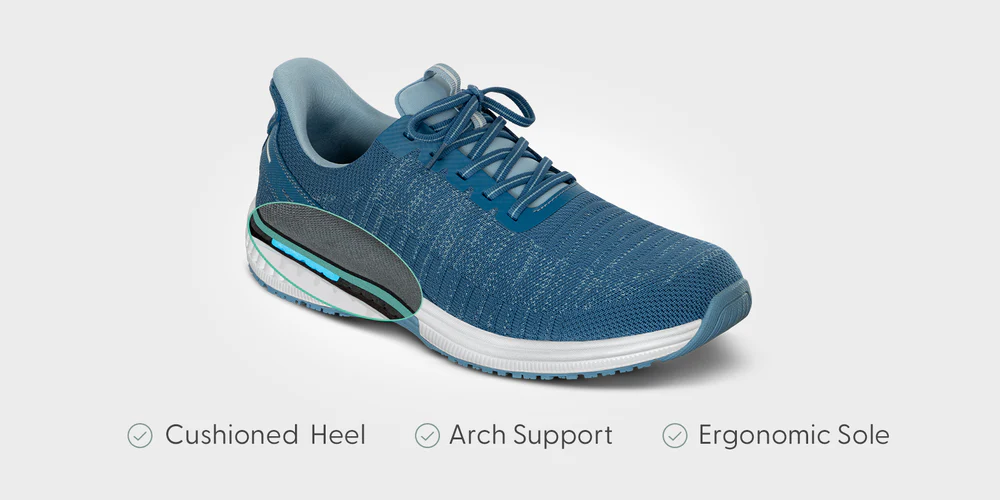
The Science Behind the Shoe: How the Right Footwear Protects People with Diabetes
Why Diabetic Shoes and Custom Inserts Are Essential for Preventing Ulcers and Protecting Mobility.
An Interview with Stu Wittner, Certified Pedorthist for Orthofeet, a leading supplier of footwear and orthotics to the medical community for over 40 years.
When you live with diabetes, you learn to pay attention to your diet, your medications, and your blood sugar levels. But for millions of Americans, one of the most important, and most overlooked parts of diabetes care starts at ground level: your feet.
To understand why diabetic footwear is such a crucial part of preventive care, we sat down with Stu Wittner, a Certified Pedorthist with more than two decades in the medical device industry. Before entering the world of orthotics and diabetic footwear, Stu worked with iconic brands like Converse, Rockport, and Timberland — and eventually brought that experience into the medical field.
Today, he works closely with clinics, podiatrists, and medical equipment providers like MCB DME to help patients protect their feet, preserve mobility, and prevent amputations through the proper use of therapeutic shoes and inserts.
Understanding the Scale of the Problem
Stu begins with a sobering statistic:
“The estimate is that there are about 100 million Americans who either have diabetes or are prediabetic,” he says. “That’s nearly one-third of the U.S. population, and many of them are at risk for foot complications.”
For people with diabetes, neuropathy (a loss of sensation caused by nerve damage) is one of the most common and dangerous complications. When patients can’t feel their feet, small issues like blisters or friction can go unnoticed. Over time, these can develop into ulcers, infections, and, in severe cases, amputations.
“Imagine walking with a pebble in your shoe and not feeling it,” Stu explains. “For someone with neuropathy, that’s a reality. What could have been a minor irritation can become a serious medical emergency.”
According to the Centers for Disease Control and Prevention (CDC), approximately 85% of diabetes-related amputations begin with a foot ulcer. That’s why prevention (not just treatment) is so critical.
How Medicare Helped Change the Outcome
The Medicare Therapeutic Shoe Bill, enacted over 25 years ago, was a turning point in diabetic foot care. The government recognized that properly fitted shoes could dramatically reduce amputations and save lives and money.
“The government ran a study,” Stu recalls. “One group of diabetic patients wore their regular shoes. The other group was given high-quality diabetic shoes and inserts. The second group saw a dramatic decrease in foot complications.”
The outcome was clear. As Stu puts it:
“The government would rather pay $300 for shoes than $30,000 for an amputation.”
To make this possible, Medicare covers 80% of the cost for diabetic shoes and three sets of custom inserts each year for eligible patients. To qualify, patients must be Medicare beneficiaries diagnosed with diabetes and must have one or more of six qualifying conditions - such as neuropathy, calluses, deformities, or poor circulation.
More details about this benefit can be found directly through Medicare.gov’s Therapeutic Shoes for Persons with Diabetes program.
What Makes a Diabetic Shoe Different?
To the untrained eye, today’s diabetic shoes might not look very different from high-end sneakers or casual footwear and that’s a good thing. But beneath the surface, there are key engineering details that make all the difference in Orthofeet products.
“The goal,” Stu says, “is to eliminate friction, pressure, and heat — the things that lead to ulcers.”
Key Design Features:
Seam-free interiors: Traditional shoes often have interior stitching that can rub against the skin. Diabetic shoes are designed to be completely seam-free, preventing irritation.
Padded linings and breathable materials: Soft, stretchable fabrics conform to the foot, preventing hot spots and pressure points.
Removable insoles: These create space for orthotics or custom inserts without making the shoe too tight.
Extra depth and width options: Accommodate swelling, braces, or special inserts.
Supportive outsoles: Designed to reduce strain and promote natural gait mechanics.

“Years ago, diabetic shoes were heavy, stiff, and not very attractive,” Stu admits. “But as footwear got more casual, we could start making shoes that look great and still meet medical standards. Patients don’t have to choose between health and style anymore.”
You can explore several diabetic footwear options directly through MCB DME’s product line, which includes brands engineered specifically for patients with neuropathy and circulation issues.
The Rise of Hands-Free Footwear
One of the biggest innovations in recent years is hands-free shoe technology. Orthofeet was among the first to introduce it to the medical world.
“Once you experience hands-free shoes, you don’t want to go back,” he says. “They’re not just convenient, they’re life-changing for people who have difficulty bending, tying laces, or balancing.”
For older adults, people with limited mobility, or anyone managing edema or obesity, being able to slip shoes on and off easily without compromising fit can make a world of difference.
Market research now predicts that 25% of all footwear will be hands-free within five years. “That’s not just a medical trend,” Stu adds. “It’s the direction the entire footwear industry is heading.”
The Art and Science of Fitting
Stu is quick to point out that proper footwear isn’t only about what you wear, it’s about how it fits.
“Fitting is not a science; it’s an art,” he says. “Two people can wear the same size, but one likes a snug fit and the other prefers extra space. Every foot is different.”
There’s no universal sizing standard among manufacturers. That’s why working with trained professionals like the specialists at MCB DME’s fitting centers is essential.
“Our goal at Orthofeet,” Stu explains, “is a perfect first-pair fit. We measure success by how often the first pair fits the patient correctly. That saves everyone time, frustration, and ensures the patient’s comfort and safety.”
Orthotics and Inserts: The Foundation Inside the Shoe
Orthotics play a major role in diabetic foot protection. They reduce pressure, stabilize the gait, and improve overall comfort.
Stu explains the two main types:
Prefabricated orthotics: Ready-made insoles designed for general support and alignment.
Custom orthotics: Created using digital foot scans or molds tailored to the exact shape of a patient’s foot.
“You don’t always need custom orthotics right away,” Stu says. “Many patients start with prefabricated options. But when you need a custom device, accuracy matters, and that’s where technology comes in.”
MCB DME offers both types, along with lymphedema pumps and other supportive devices to reduce swelling and improve circulation.
Technology That’s Reshaping the Industry
The world of orthotics has gone digital. Foot scanning technology, once limited to research labs, is now available in clinics and even on smartphones.
“You can scan a foot with an iPhone or iPad,” Stu explains. “It’s faster, cleaner, and more accurate than foam molds or plaster casts. Ten doctors can make ten different casts, but a digital scan gives you precision every time.”
Digital tools also allow Orthofeet to store 3D models, track changes in foot shape over time, and create more personalized support for every patient.
The National Institutes of Health (NIH) has supported ongoing research into digital orthotic fabrication, citing faster turnaround and reduced patient risk as key advantages.
Collaboration Between Clinicians and Manufacturers
Orthofeet maintains a constant feedback loop with medical professionals, something that’s helped refine and innovate products for decades.
“We work with thousands of clinics, doctors, and fitters,” he says. “We listen. If a strap is too short, or a material causes heat, we fix it. Orthofeet takes their feedback seriously because they’re the ones treating patients every day.”
This collaboration has led to improvements in comfort, fit, and functionality — from new strap designs to improved cushioning systems and better arch support.
At MCB DME, that same philosophy applies: every product is backed by education, training, and direct collaboration with healthcare providers who specialize in diabetic care.
The Power of Prevention: Why Footwear Matters More Than Ever
The most important takeaway, Stu says, is that prevention is everything.
“Even the best doctor can’t prevent what happens when a patient walks around in unsafe shoes,” he explains. “We can treat wounds, but preventing them is always better.”
Regular self-inspection, proper footwear, and ongoing communication with healthcare providers can reduce the risk of amputation by up to 85%, according to the American Diabetes Association (ADA).
Read the ADA’s guide to diabetic foot care → Download the PDF
Stu stresses that while appearance and fashion once limited patient compliance, that’s no longer an excuse.
“Patients used to say, ‘I don’t want to wear those shoes — they look medical.’ Now they’re saying, ‘I can’t believe this is a diabetic shoe.’ The design evolution has changed everything.”
Looking Ahead: Innovation and Access
When asked what’s next for diabetic footwear, Stu sees two big trends:
Greater access through awareness.
“Many patients don’t even know they qualify for a Medicare-covered pair each year,” he says. “Educating both patients and providers is key.”Continued innovation.
With scanning, new materials, and hands-free technologies, diabetic footwear will continue to evolve toward a perfect blend of function, comfort, and fashion.
For MCB DME, that future is already here. The company partners directly with physicians and manufacturers to make sure every patient gets the right fit from the first step.

Take the Next Step Toward Healthier Feet
If you or someone you care for lives with diabetes, don’t wait for symptoms to worsen. Proper footwear is one of the simplest, most effective ways to protect your health.
Explore MCB DME’s diabetic footwear collection or contact our team to schedule a fitting or learn more about the Medicare Therapeutic Shoe Program.
Our specialists can guide you through qualification, documentation, and selection, ensuring you get both comfort and coverage.
Key Takeaways
1 in 3 Americans lives with diabetes or prediabetes.
Neuropathy increases risk of ulcers and amputations.
Medicare covers 80% of diabetic shoe and insert costs annually.
Modern diabetic shoes combine protection and style.
Hands-free and digital scanning are revolutionizing fit and accessibility.
As Stu sums it up:
“The right shoe isn’t just about comfort, it’s about quality of life. With proper fit, design, and care, we can help people keep walking, stay active, and live independently for years to come.”
Learn more about Orthofeet and their upcoming Black Friday sale at https://www.orthofeet.com/.

